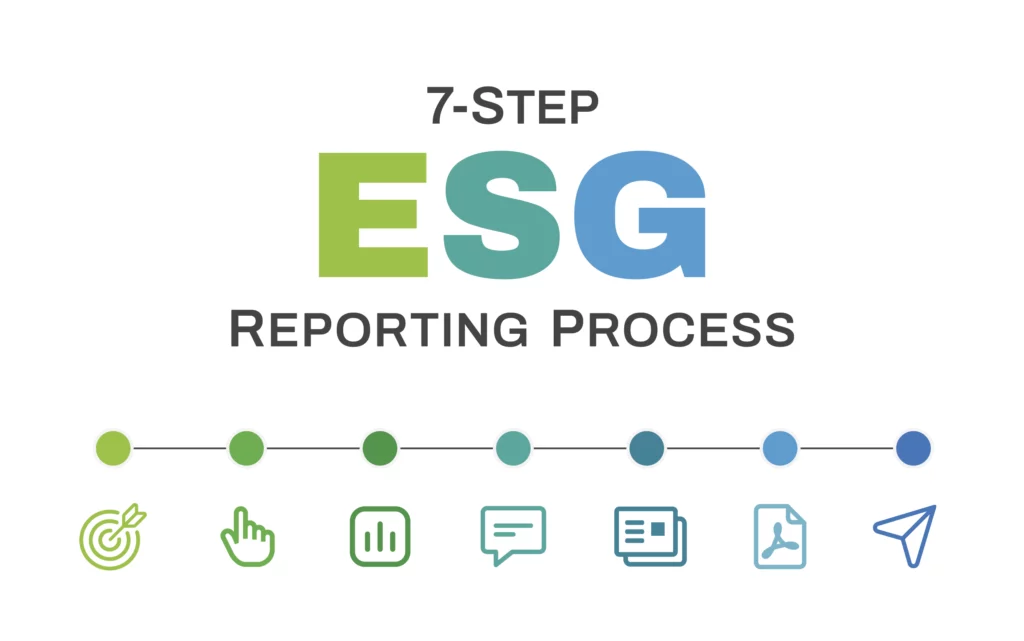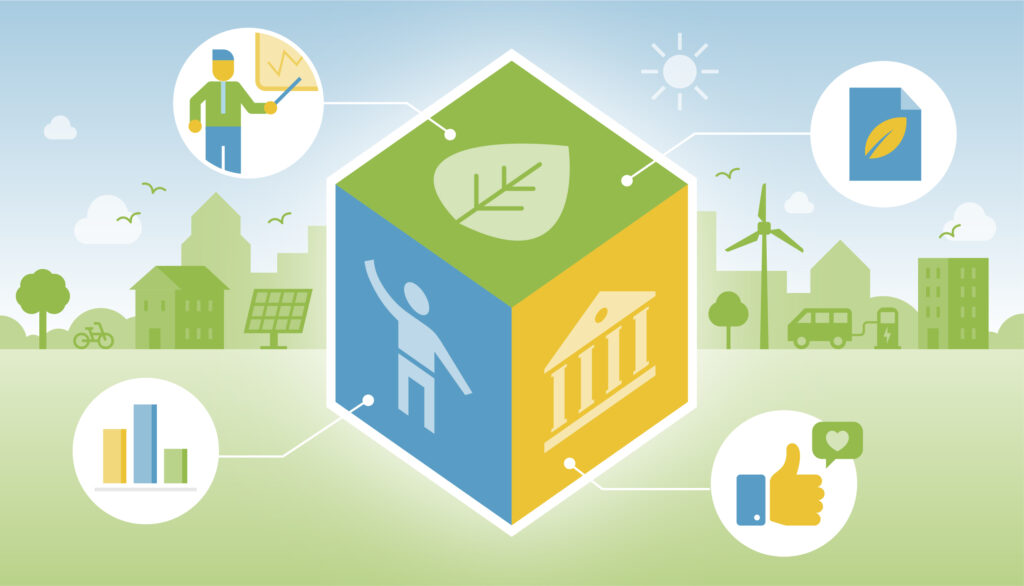Best Practices for Sustainability Report Design
Sustainability & ESG, Guides / March 7, 2024
By Adam Franke
Sustainability report design is essential for effectively communicating a company’s ESG initiatives. A well-crafted report can capture the attention of stakeholders and enhance transparency.
Effective design goes beyond aesthetics; it fosters understanding of complex information. Companies can significantly improve readability through strategic content organization, compelling storytelling, leveraging digital innovations, thoughtful use of white space, and engaging layouts.
This guide outlines best practices for sustainability report design, emphasizing key elements of practical design and impactful storytelling to enhance stakeholders’ understanding of your company’s sustainability initiatives and their impact.
Understanding the Role of Sustainability Reports
Sustainability reports are more than just a corporate obligation. They are a powerful tool for building trust with stakeholders, including investors, employees, customers, and the wider community.
These reports provide a transparent account of a company’s ESG efforts and achievements. They showcase the company’s commitment to sustainable practices, its progress towards sustainability goals, and its plans for the future. A well-designed sustainability report can effectively communicate this information, making it accessible and engaging for a broad audience.
Key Elements of Effective Sustainability Report Design
Designing a sustainability report is a complex task. It requires a balance of aesthetics, functionality, and content. The design should not only be visually appealing but also enhance the readability and comprehension of the report.
Using visual white space, infographics, and data visualization can greatly improve the report’s effectiveness. These elements can help convey complex information in a simple and engaging manner.
The key elements of effective sustainability report design include:
- Horizontal or landscape format
- Global navigation
- Balancing text, visuals, and white space
- Infographics and data visualization
- Alignment with company branding
- Include relevant and quality imagery
Adopt a Horizontal or Landscape Format
Adopting a horizontal, also known as landscape, page layout aligns with the design of computer monitors and laptops. This reduces the need for scrolling and utilizes the entire screen space, which is the favored format for the majority of reports published today.
Incorporate Global Navigation
Organizing your report clearly around the main topics is important to make it easy to read and understand. Most sustainability reports are in PDF format. We recommend incorporating a global navigation system that will serve as a roadmap for exploring the report.
Including hyperlinks can also be helpful. They allow readers to easily jump to different sections or external resources, such as websites and videos, for more details.
Utilizing Visual White Space
Visual white space is a powerful design tool. It can improve readability and comprehension by breaking up text and making the report easier to navigate.
White space can also draw attention to key information and make the report more visually appealing.
For example, we created visually spacious opener pages for each section of the Fortune Brands ESG Report. This made key topics easier to understand and absorb when they were presented in a simplified way.
Incorporating Infographics and Data Visualization
Metrics and data are vital in narrating your ESG journey. Your stakeholders are keen on knowing about your progress, so it’s essential to be transparent and realistic about what you know and what you don’t. It’s important to demonstrate the trajectory in which you are heading, even if measuring or benchmarking is challenging. Highlight key statistics, ongoing progress, and comparisons with peers throughout the report, ensuring transparency.
Infographics and data visualization can transform complex data into engaging visuals. They can help stakeholders understand your company’s sustainability performance at a glance. These visuals can also highlight trends, comparisons, and progress towards sustainability goals.
Aligning Design with Branding
The design of the sustainability report should align with the company’s branding. This includes using colors, fonts, and imagery that reflect the company’s brand identity.
Consistent branding can enhance the report’s credibility and strengthen the company’s overall brand image.
Create and select quality imagery
Images play a crucial role in defining your brand. Refrain from utilizing generic and commonplace stock images. Despite their convenience, such options might not always yield the best results. It’s not unusual to spot identical stock images in numerous reports, even within the same sector.
Similarly, avoid using low-quality images captured on smartphones. Smartphone pictures often suffer from low resolution, inadequate lighting, or poor cropping. Learn more about maximizing smartphone photo quality.
Consider investing in custom photography to connect with your audience and demonstrate your commitment to ESG principles. By capturing images of your team, operations, and facilities, you can embody your brand values and build stronger relationships with your audience. Find out more about creating effective ESG image strategies.
Structuring Your Sustainability Report
The structure of your sustainability report plays a crucial role in its effectiveness. A well-structured report is easy to navigate and understand. It guides the reader through the content in a logical and coherent manner.
The structure should be designed with the reader in mind. It should be intuitive and user-friendly, allowing readers to easily find the information they are looking for.
Key considerations for structuring your sustainability report include:
- Crafting a clear executive summary
- Organizing content for accessibility
- Balancing text, visuals, and white space
Crafting a Clear Executive Summary
The executive summary is one of the most important sections of your sustainability report. It provides a high-level overview of the report’s content.
It should be clear, concise, and compelling. It should highlight the key findings, achievements, and challenges, enticing the reader to delve deeper into the report.
Organizing Content for Accessibility
It is crucial to organize the content in your report for accessibility. This means structuring the report so that readers can easily find and understand the information they need.
This could involve using clear headings, subheadings, and bullet points. It could also mean including a user-friendly table of contents and navigation.
Balancing Text, Visuals, and White Space
Balancing text, visuals, and white space is a key aspect of effective report design. Too much text can be overwhelming, while too many visuals can be distracting.
The right balance can enhance readability and comprehension. It can make the report more engaging and visually appealing, while ensuring the content is clear and easy to understand.
Engaging Stakeholders with Storytelling
Storytelling is a powerful tool in sustainability report design. It can bring your sustainability efforts to life, making them more relatable and engaging for your stakeholders.
By weaving a narrative throughout your report, you can illustrate the impact of your sustainability initiatives in a compelling way.
The Power of Narrative
Narrative can transform dry facts and figures into a compelling story. It can help illustrate your organization’s journey towards sustainability.
Explaining the methodology behind your data collection and analysis can provide context and depth to your sustainability story.
Case Studies and Testimonials
Case studies and testimonials can add a human element to your sustainability report. They can provide real-world examples of your sustainability initiatives in action.
Including quotes from leadership and stakeholders can also add credibility to your report. It can demonstrate your organization’s commitment to sustainability and its impact on people and the planet.
Leveraging Digital Innovations
Digital innovations are transforming the landscape of sustainability report design. They offer new ways to engage readers and present information more interactively and engagingly.
Interactive Elements and User Experience
Interactive elements can enhance the user experience of your sustainability report. They can make your report more engaging and easier to navigate.
For instance, interactive charts and graphs can allow readers to explore data in more depth and convey complex information in a more accessible way.
The Shift to Digital Reports
The shift towards digital reports is a significant trend in sustainability reporting. Digital reports offer several advantages over traditional printed reports. For one, they are more accessible to a global audience. They also offer the potential for interactive elements, enhancing the user experience.
Deepen the impact of your ESG story
Promote your sustainability achievements to investors, employees, and suppliers through ESG marketing, which offers opportunities to share your company’s ESG highlights and goals. This enhances stakeholder engagement and boosts brand reputation. Consider thought leadership campaigns and awareness programs to further spread your message. For more insights, read our article on marketing your ESG strategy.
Also consider creating a thought leadership campaign or promotion through traditional and digital media. Additionally, awareness and engagement programs and campaigns can be helpful in spreading the word.
To learn more read our article on How to Market Your ESG Strategy to Stakeholders.
Adhering to Global Reporting Standards
Adherence to global reporting standards is a crucial aspect of sustainability report design. These standards provide a framework for consistent and comparable reporting.
What are Reporting Standards?
Reporting standards, such as the Global Reporting Initiative (GRI) and the Sustainability Accounting Standards Board (SASB), provide essential frameworks for sustainability reporting. They ensure consistency, comparability, and credibility in the information presented, helping companies meet stakeholder expectations and regulatory requirements. Adhering to these standards can enhance the transparency of a company’s ESG initiatives and improve stakeholder trust.
Why Credibility Matters
The importance of credibility in sustainability reporting cannot be overstated. Credibility ensures stakeholders trust the information presented in the report, which is vital for building long-term relationships. Companies should adhere to established reporting standards to enhance credibility, provide transparent data, and include third-party verification where possible. This boosts stakeholder confidence and reinforces the company’s commitment to sustainability and ethical practices.
How OBATA Can Help
At OBATA, we take pride in our corporate reporting capabilities, which extend beyond sustainability reporting. Our expertise also includes annual reporting, proxy design, and investor communications. We know it’s important to communicate a company’s values and achievements to stakeholders. We’re dedicated to helping our clients reach their reporting goals.
To find out how OBATA can help your company communicate its ESG initiatives and sustainability efforts, click the link below. We look forward to collaborating with you and helping you position your company as a leader in sustainability.


